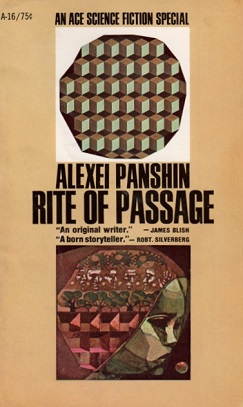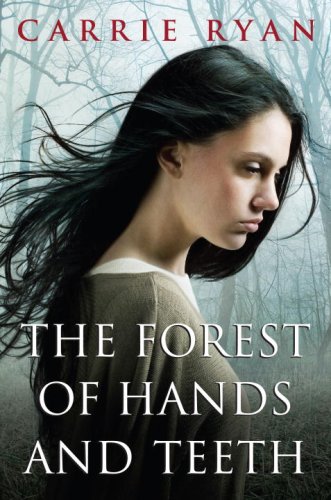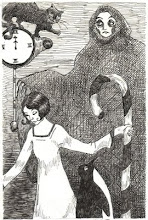All were interesting, all were worth reading to varying degrees. Two were from the late 60s, and the other three have all been released over the past couple of years. Young Adult fantasy is incredibly popular right now (Twilight. Duh.), most of it with female protagonists, much of it very good indeed. It just seemed such an odd coincidence that I read all these books in such close proximity to each other. As someone on a YA book board recently exclaimed: "Is post-apocalyptic teen fiction now a genre?"
 When Rite of Passage by Alexei Panshin first came out in 1968, it won the Nebula and was a Hugo Award finalist. So it's not like is was exactly ignored upon its release. At first, I wasn't going to include it in my post as this is actually a re-read. It was one of my favorite books when I was a teenager, so it seems like a total shame that kids now don't seem to be reading it much. The story is set about 150 years after the Earth became uninhabitable do to overpopulation, famine and war. Mia Havero, who is eleven years old when the book starts, lives aboard one of several large, city sized ships that escaped Earth before its final destruction. Numerous colonies have also been set up on various planets. One thing that surprised me upon rereading was how unlikable Mia sometimes is. She's prickly, impatient and intolerant. She throws around the word "mudeaters", the slur the ship dwellers use to denigrate the people who live on the planets. She is smart and arrogant. But she's also brave and intellectually curious. In a closed society like the Ship's, there is little disease, few accidents and people live a very, very long time, so population control is of prime importance to the ship's counsel. One of the ways this is effected is through "The Trial". When kids turn fourteen, they are put down on a planet and have to survive for a month. They are given extensive survivalist training in order to ensure that a good number make it through.
When Rite of Passage by Alexei Panshin first came out in 1968, it won the Nebula and was a Hugo Award finalist. So it's not like is was exactly ignored upon its release. At first, I wasn't going to include it in my post as this is actually a re-read. It was one of my favorite books when I was a teenager, so it seems like a total shame that kids now don't seem to be reading it much. The story is set about 150 years after the Earth became uninhabitable do to overpopulation, famine and war. Mia Havero, who is eleven years old when the book starts, lives aboard one of several large, city sized ships that escaped Earth before its final destruction. Numerous colonies have also been set up on various planets. One thing that surprised me upon rereading was how unlikable Mia sometimes is. She's prickly, impatient and intolerant. She throws around the word "mudeaters", the slur the ship dwellers use to denigrate the people who live on the planets. She is smart and arrogant. But she's also brave and intellectually curious. In a closed society like the Ship's, there is little disease, few accidents and people live a very, very long time, so population control is of prime importance to the ship's counsel. One of the ways this is effected is through "The Trial". When kids turn fourteen, they are put down on a planet and have to survive for a month. They are given extensive survivalist training in order to ensure that a good number make it through.By the end of the book, we view the Ship as being a kind of lazy Death Star without the histrionics, Nazi iconography and ultra-militarism. Ship society has become decadent, complacent and arrogant (much as Mia was at the beginning of the book). No one creates any new art, they take resources from and exert ultimate control (via the threat of nuclear annihilation) over the planet colonies, withholding technology from the hard-scrabble, mostly rural planet dwellers. What's so interesting, and feels so real about the book is that Mia's father who is a firm supporter of all the policies outlined above, is also in the ordinary, day to day sense, a very nice man. Everyone thinks they are right and working for the ultimate good in their own quiet way. There is no mustache twirling, no clear villains and no easy solutions. There's no rebellion of the planet dwellers creating a new egalitarian society. There's just one girl's awakening to the fact that the way her Ship operates isn't right and that she will do what she can to change things. If I've made this sound overly dry, I apologize. Though Panshin is a slightly chilly writer emotionally, Mia's month long Trial is super exciting (and - bonus! consequence-free teen sex!) and her adventures aboard ship are loads of fun, and there's lots of regular coming of age stuff with friends and school. The title "Rite of Passage" may be heavy handed, but the book isn't. I have a feeling one of the big problems with people not reading this book are the really unfortunate covers it has been saddled with for the past 2o years. I mean, really.
 The Forest of Hands and Teeth by first-time novelist Carrie Ryan, is a muted Zombie Apocalypse romance that is full of dread. I mean that in the nicest way possible. She never uses the word "zombie" in her book, the creatures in the forest are instead referred to as the "Unconsecrated". Becoming unconsecrated is viewed as both a disease and a curse.
The Forest of Hands and Teeth by first-time novelist Carrie Ryan, is a muted Zombie Apocalypse romance that is full of dread. I mean that in the nicest way possible. She never uses the word "zombie" in her book, the creatures in the forest are instead referred to as the "Unconsecrated". Becoming unconsecrated is viewed as both a disease and a curse.The novel is set some generations after the Unconsecrated have seemingly overrun the earth. Mary lives in a small, fortified village in the forest which is run along strict religious lines by an order of Sisters, backed up by the force of the Guardians who patrol the borders. I say "seemingly" because there don't seem to be any lines of communication open between Mary's town and the rest of the world. She isn't certain there is a "rest of the world". The town is bordered by a fence, beyond which is the Forest of Hands and Teeth - the hunting ground of the unconsecrated.
I took a look at a few reviews before writing this, and everyone describes the book in the same way. They use simple fairy tale sentences. There is a girl named Mary and she lives in a town surrounded by woods. The first half of the book is extremely powerful. It doesn't feel entirely unlike a story about a medieval village when the black plague comes to town. She hits that sweet spot between specificity and universal allegory that is very, very hard to do. You can get a pretty good feel for it from the lovely first paragraph:
My mother used to tell me about the ocean. She said there was a place where there was nothing but water as far as you could see and it was always moving, rushing toward you and then away. She once showed me a picture that she said was my great-great-great-grandmother standing in the ocean as a child. It has been years since, and the picture was lost to fire long ago, but I remember it, faded and worn. A little girl surrounded by nothingness.I think the book falls apart a little at the end. Mary and a few others wind up traveling down a fenced in path, the unconsecrated hoards constantly trying to break through. Look. I'm all for zombies. But after a week of them traveling like this, I began to ask, "What is that fence made of?" Ryan seemed to lose control a little bit as the masses of zombies swamp the narrative in yuck and gore. There are just too many of them. Which I guess is the whole point of a zombie apocalypse so I can't complain. But all of Ryan's missteps feel like rookie errors and she has a sequel on the way which I am very excited about (called The Dead-Tossed Waves. Out in March.). From the advance materials, it looks as if it doesn't pick up directly from where Forest left off, but skips a generation or so. I think this was a smart move and I'm curious to see where her lovely prose and morally complex zombie world wind up leading.
 Scott Westerfield's Uglies books have an interesting premise (out of the four, I read the first two: Uglies and Pretties), but felt overly simple in execution. I enjoyed the first book. Our teenage heroine, Tally Youngblood, lives in a post-apocalyptic, post-scarcity, seeming utopia. When each person turns sixteen they are made "pretty". i.e. they are given head to toe plastic surgery and move to "New Pretty Town", a kind of late adolescent Pleasure Island of parties and cocktails and fun and decadence. Kids who haven't yet had the surgery are called "Uglies". Tally wants to be pretty more than anything. If you smell a dystopia looming, you'd be correct. It's creepy as hell, and Tally learns a few things that puncture her pretty-perfect view of the world she was born into. She learns about the big brother-like Secret Police (called Specials) who have been surgically altered to be strong, fast and monstrous. She also learns about, and eventually makes her way to "The Smoke", a camp of deserters who live in the wilderness, un-surgeried. While there, even more sinister facts emerge. The new pretties aren't so up and "bubbly" (and, wow, will you get sick of the word bubbly in the second book) because their lives are now so fabulous, but because they've been essentially lobotomized, and made docile.
Scott Westerfield's Uglies books have an interesting premise (out of the four, I read the first two: Uglies and Pretties), but felt overly simple in execution. I enjoyed the first book. Our teenage heroine, Tally Youngblood, lives in a post-apocalyptic, post-scarcity, seeming utopia. When each person turns sixteen they are made "pretty". i.e. they are given head to toe plastic surgery and move to "New Pretty Town", a kind of late adolescent Pleasure Island of parties and cocktails and fun and decadence. Kids who haven't yet had the surgery are called "Uglies". Tally wants to be pretty more than anything. If you smell a dystopia looming, you'd be correct. It's creepy as hell, and Tally learns a few things that puncture her pretty-perfect view of the world she was born into. She learns about the big brother-like Secret Police (called Specials) who have been surgically altered to be strong, fast and monstrous. She also learns about, and eventually makes her way to "The Smoke", a camp of deserters who live in the wilderness, un-surgeried. While there, even more sinister facts emerge. The new pretties aren't so up and "bubbly" (and, wow, will you get sick of the word bubbly in the second book) because their lives are now so fabulous, but because they've been essentially lobotomized, and made docile.This is spooky, potent stuff, and Westerfield tells an exciting tale. But something about it felt overly simple to me. Some of the technology he has thought up is awe inspiring (particularly in "Pretties") and creative, but sometimes they felt like plot contrivances. The Specials are completely evil. Which I guess is partly my problem - in contrast between Mia Havero's nice father deciding to push the button to annihilate an entire planet because he really, really thinks its his only choice - we have what I call mustache twirling. Evil for evil's sake that delights in its own evil. I mean, they do say they want to preserve their way of life and look what happened before, etc. But they practically kick puppies. Also, the major betrayal and the reaction to it felt off. It's over a boy that Tally's friend liked first. And when he likes Tally better she becomes completely evil. Which is just stupid. The characters are at the service of the plot.
If I can get it for free, I may read "Specials" to see how it all turns out (here's a hint: evil loses), but Westerfield's world, while very sparkly indeed, lacks depth. And maybe it just hit me wrong, but Westerfield seems awfully enchanted by the Pretties outsides, while bemoaning their insides. Which doesn't sound very different from certain dystopian aspects of our our current, non-apocalyptic world.
Apocalypse Girls will continue with Suzanne Collins' Hunger Games and Angela Carter's Heroes & Villains.

















No comments:
Post a Comment